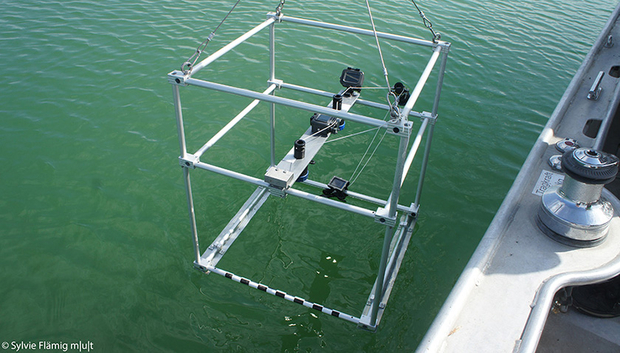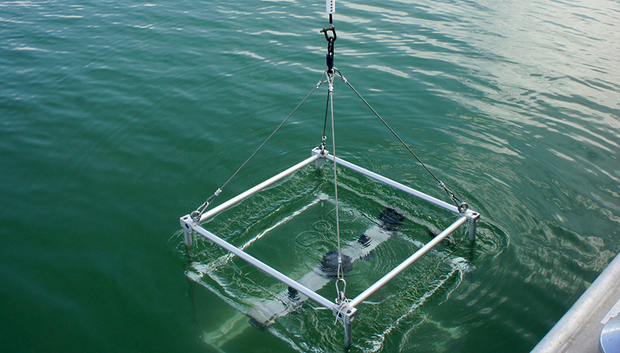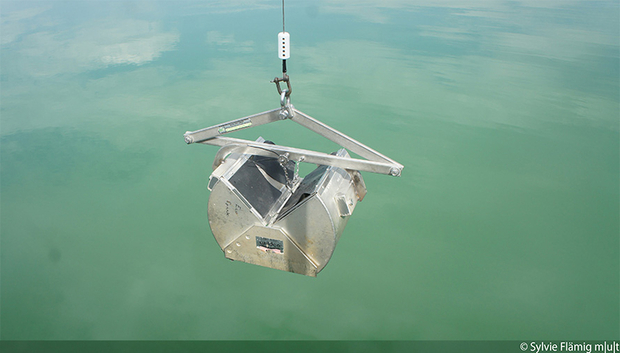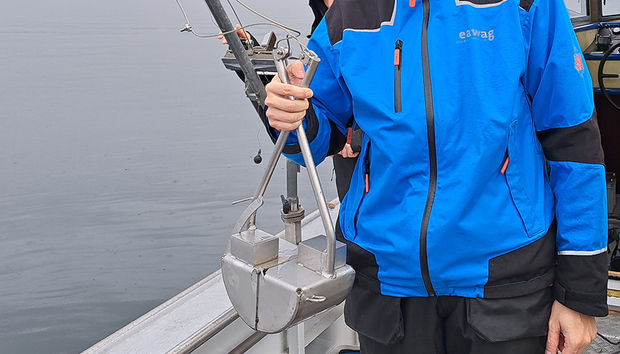Department Aquatic Ecology
Standardised Monitoring of Quagga Mussel Spread in Swiss Lakes and Support for Prevention and Protection Measures
Since their first discovery in 2014 in the Rhine in Basel, the invasive quagga mussel (Dreissena rostriformis) has spread to multiple Swiss lakes and rivers. Today it can be found in Lake Constance, Lake Geneva, Lake Neuchâtel, Lake Biel, Lake Morat, Lac de Joux, Lac de l’Hongrin, as well as Rhine and Aare. A possible invasion of Lago Maggiore and Lago di Lugano is under investigation. In contrast to the closely related zebra mussels (Dreissena polymorpha), which has been invasive in Switzerland since the 1960s, the quagga mussel can live even at the deepest depths of our lakes, grow on both hard and soft substrates, and can reproduce throughout most of the year. In lakes where quagga mussels can be found, they have replaced zebra mussels almost entirely. Due to their mass occurrence (often more than 5’000 individuals per square meter, up to almost 40’000) and their rapid reproduction, the quagga mussel can drastically change the affected lake’s ecosystem, ultimately replacing native species, and endanger fish stocks through the reduction of available nutrients in the water and subsequent effects on the food chain. Further, their growth on and in aquatic infrastructure, especially in pipes carrying lake water, is a major problem.
Once the quagga mussel has established itself in a lake, it cannot be exterminated. Thus, it is essential that the mussels are not transferred to currently quagga-free lakes. To this end, Eawag is working with the federal government and the cantons to develop a concept that is as uniform as possible throughout Switzerland, both for early detection in unaffected lakes and rivers, and for longer-term monitoring of quagga mussels in affected waters. At the same time, in cooperation with the association of cantonal neobiota agencies "Cercle Exotique" and other stakeholders, such as water and heat suppliers, work is being done on the further development and harmonisation of prevention and protection measures (e.g. guidelines for the transport of materials (boats, equipment, etc.), uniform conditions in cantonal permits, better education and protection measures for lake water users).
BIS – Benthic Imaging System
The BIS enables visual inspection of the lakebed to detect the presence of quagga mussels. Two GoPro® cameras (for top and side views), underwater lighting, and a dive computer are mounted on an aluminium frame. The system is deployed from a boat and lowered to the lakebed using a winch (typically three deployments per sampling location). The resulting video files are analysed by Eawag over the course of the project. Analyses focus on presence/absence of quagga mussels and infestation intensity. Through repeated assessments at the same sites, changes in benthic coverage and mussel density over time and at different depths can be tracked. In the future, automated image recognition software will be used for data processing.
Ponar Grab Sampler / Van Veen Grab Sampler
The Ponar grab sampler is a device weighing over 20 kg, designed to retrieve sediment samples from the bottom of water bodies. Thanks to its substantial weight, it can penetrate the sediment autonomously and collect large samples (up to 8.2 litres). It is deployed from a boat using a (semi-)automatic winch and a steel cable or heavy-duty rope.
The Van Veen grab is a smaller, lighter version of the Ponar. Weighing around 7 kg (sample volume ~2 litres), it can be used without a winch, making it suitable for smaller boats.
Samples are sieved, and any mussels present can be collected. These are then counted and measured to assess age distribution and growth patterns of quagga mussel populations. Typically, three sediment samples are collected per site using the Ponar, and up to five using the Van Veen to compensate for its smaller sample volume.
Subprojects
To curb the spread of the quagga mussel in Switzerland as effectively as possible, a monitoring strategy was developed in collaboration with the affected cantons. The aim is to implement standardised surveillance in both infested and uninfested lakes to improve understanding of quagga mussel dispersal dynamics in Swiss waters. This knowledge serves as a foundation for the development of effective prevention and protection measures. As part of the monitoring implementation and targeted data collection on quagga mussel populations in Swiss lakes, the following subprojects and areas of activity are being undertaken:
- Coordination and contact point for prevention and protection measures, including evaluation of their effectiveness.
- Coordination and contact point for citizen science initiatives (reporting and submission of mussel findings).
- Support for early detection: regular environmental DNA (eDNA) monitoring is planned for lakes without confirmed quagga mussel presence.
- Monitoring of designated “research lakes” to assess long-term developments and specific impacts on Swiss water bodies.
- Support for cantonal monitoring: all other infested lakes with quagga mussel populations should be sampled annually with minimal effort (1–2 days per year). The Eawag Quagga Mussel Competence Center provides assistance with sampling design, fieldwork, data analysis, and data sharing with federal and cantonal authorities.
- Support and coordination of responses to new invasions.
The detailed monitoring concept is available here. We are pleased to support interested cantons in planning and implementing quagga mussel monitoring efforts. Please do not hesitate to contact us with any questions or expressions of interest:
quagga@cluttereawag.ch, info@cluttersf-mut.com, piet.spaak@cluttereawag.ch.








